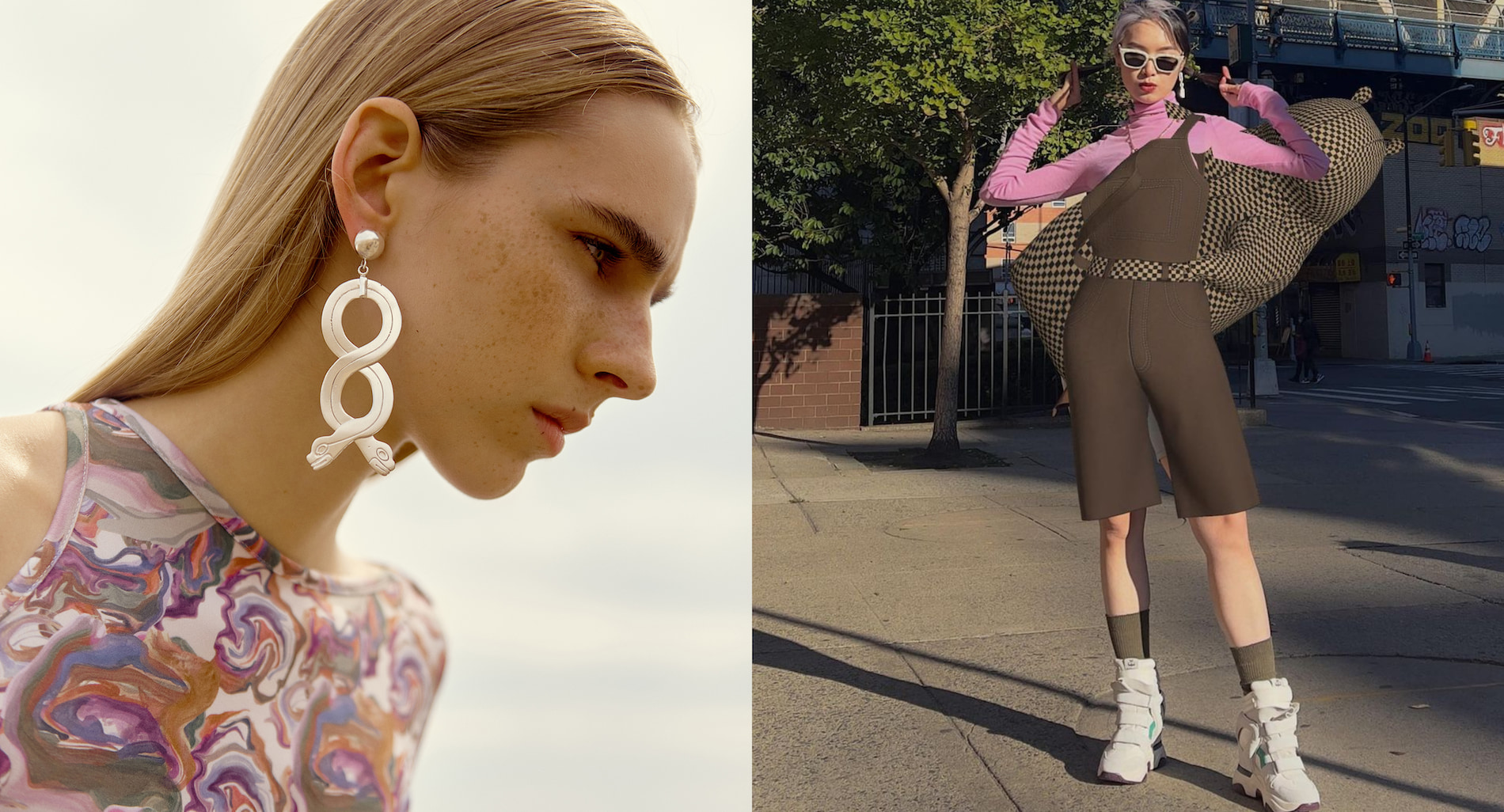Marisa Fuentes Prado is a Peruvian fashion designer with a long trajectory in the industry in Latin America before moving to Europe. Her brand, Maqu, it’s a timeless, conscious womenswear label with a focus on classic & practical shapes. With her designs, Maqu proposes not only a visual but also a tactile experience. Marisa’s projects also involve keeping traditional Peruvian techniques alive through her Alpaca collections.
Yifan Pu (浦一凡) is a digital fashion artist and designer. Coming from a product design background, Yifan found digital fashion as the perfect tool to combine her interest in fashion with her skills in 3d. Her practice ranges from digital art, AR filters to practical usage of digital fashion, e.g. digital sampling for fashion houses. Her works have been seen in Vogue, i-D, KALTBLUT, among other publications.
The need to represent ideas and concepts through fashion has driven many designers to develop interdisciplinary skills that overlap with their crafting of fabrics, prints, and other materials. With the pandemic, the demand for virtual fitting and personalized fashion has increased dramatically. This represents a challenge that is partially met (by big companies), constructing models where fashion trends are created based on big data and digitalization. But consumers are quickly shifting opinions and consumption patterns, and independent designers are proposing, listening, and betting for new ways to shift the industry. What will be next in fashion then?
DM: Let’s start at the beginning: where does your creative process start? How does it overlap with digital design?
Yifan: I first got exposed to digital design tools when I studied product design in Shanghai. I didn’t enjoy the program, although I liked the expressive stage of concept design. Later on, I moved to Berlin and studied media art. One day, I came across CLO3d, a tool that is now my daily partner. It’s a 3D tool specialized for fashion design that perfectly suits me, because I love designing styles, as opposed to working with physical fabrics. From that moment on, I started teaching myself about digital fashion design, and now, I’m an independent digital artist focused on digital fashion.
Marisa: The creative process is something of a reflective path for me. After collecting diverse ideas, I begin to put together a storyboard. This I usually need to do in solitude, to reflect and give it new perspectives.
As a fashion designer, I have always been influenced by different branches of design and, with time, I’ve come to realize that it’s an ongoing process to develop new skills and update old ones. I find it important to create interaction through digital campaigns.
DM: Brands are constantly looking for the perfect way to communicate their identity and differentiate themselves from the bunch. But independent fashion designers can’t always hire an in-house marketing team, or a specialized agency to bring their ideas to the market. How do you go about these key business moments?
Marisa: I can identify with that statement. To transmit our values online, or in a shop, has become a constant struggle. Our consumers follow us because they want to, and we continue to develop our SoMe profiles and come up with honest content, without masks, but there is too much information out there and it can feel like a lost battle. I used to be very skeptical about hiring extra hands for this, but this year I’m giving it a go and we’re actually working with a specialized advisor.
Yifan: I started as a fashion hobbyist posting my digital fashion works on social media. My 3D designer peers showed a lot of support, which helped me earn exposure. This is a thing: 3D communities are really lovely!
During the pandemic, more physical fashion brands and indie designers got interested in digital fashion as an alternative for campaigns or as a sampling and visual aid for production. This had an impact on my work and I’ve archived those projects on my website.
Helsinki Fashion Week in 2020 was a boldly fully digital fashion event that gave me a great chance to connect with physical fashion brands, sustainable fashion advocates, digital artists, and studios. Some of them became my collaborators and clients. I also had the honor of being featured in some press from that event. This proves that a supportive platform is key for businesses to prosper.
Digital fashion platforms like Dressx, XR Couture, Digital Fashion Week New York, and Zero10 app are all dedicated to providing digital fashion designers with exciting user scenarios and potential monetization channels. Using available tools and reaching out for help is another key element to growing in the industry.
DM: Graphic design requires a lot of observation and critical thinking. It’s not only made to please the eye, right? How to convert your personal taste to a graphic representation that should be liked by others? Considering your consumers may be people who are used to other cultural expressions than yours.
Yifan: Cultural difference is one of my favorite topics as well as my biggest challenge, due to my expat identity. I’d thank social media for helping me understand my surroundings faster and often in a visual way. I think it’s also thanks to social media that people from different backgrounds are more likely to share a digital layer of common context when it comes to, for example, humor.
I learned of course a lot from my designer peers. And through them, I’m always up to date with the industry’s news, which helps me understand and predict trends better. I also learn from my followers. Social media nowadays provides insightful analysis of your followers to guide your posting. Every creator on social media probably has this love-and-hate relationship with algorithms (laughs).
With the pandemic, I’ve seen a lot more live streamings featuring the artists’ working process. As 3D communities have already been generous in sharing techniques, accessing tutorials for self-learning is now easier than ever. I surely benefit from that to keep polishing my skills and visual language.
Marisa: I believe that we are all attracted to a certain aesthetic. It’s part of being human and having a different perception of life. And I surely don’t think we can please everyone all the time! (laughs). Sometimes the compliments come from people I wouldn’t expect them to come from. This is refreshing, and at the same time, a reminder of how diversity is imprinted in all aspects of our business.
For my brand, the priority is to stay genuine. But also to stay focused on our community, because for some reason they are still there and we owe it to them. In our small team at Maqu, we use collaboration as our main tool. All content is generated after team collaboration and it just feels right when it’s out.
DM: How important is graphic design in shaping the perceptions of a fashion label?
Yifan: I can’t separate my perception of a label from its graphic design, or should I say visual communication. Nowadays, design needs to suit different platforms, and appeal to people of different ages and cultures, while at the same time maintaining a sense of consistency to keep the first followers loyal.
Marisa: I too see it very much in the essence, and as the foundation of a brand. Developing a clothing line is one thing, but building a brand is like creating a universe where people can or not see themselves. Through graphic design, we all have a clearer vision of what that brand is bringing, and if it resonates with us or not.
DM: For some people, digital design and fashion are perceived as being luxurious and even shallow. Do you think the recent changes in the world economy and the new awareness about climate have affected people’s perceptions of fashion in general?
Marisa: It’s a difficult question. Fashion has always had that luxurious halo because it’s something purposely created to give the impression that it’s unattainable. To be honest, I think a large portion of consumers are completely aware of what is going on in today’s world, and they try to go down a sustainable path. The fashion industry is still doing very little to change that frivolous image, but I’m optimistic because there are big brands and magazines that are starting to generate awareness and produce responsibly. Now it’s a question of time for our planet, right? We can no longer take things for granted, not anymore.
Yifan: From my perspective as a digital fashion designer, I see how digital tools have helped many fashion amateurs and hobbyists like me, to enter the game which has made the scene much more inclusive and diverse. Nowadays, for example, you can easily spot authentic ethnical costumes being showcased on digital fashion marketplaces.
Digital fashion tools are also increasingly integrated into fashion brands’ in-house sampling process, which assists visual communication between departments and helps cut fabric waste. Digital fashion photo fitting as an alternative for wear-once-for-Instagram outfits is another solution to cut waste, especially for the influencer scene.
DM: What do you think the design audience expects from big and independent brands now?
Yifan: Responsible moves towards sustainability. They can start small, but need to be genuine and follow up. And diversity. It’s time to have everyone represented, yet not tokenized.
Marisa: More innovation and crossing boundaries. At the same time, I think we’re invited and asked to talk about more relevant and complex topics.
You can follow Yifan’s work on Instagram or visit her website.
Follow Marisa Fuentes Padro on Instagram or visit her website.
Cover photo: Chavin earrings by Maqu, photo by Alex Perez. / Capybara digital design by Yifan Pu




